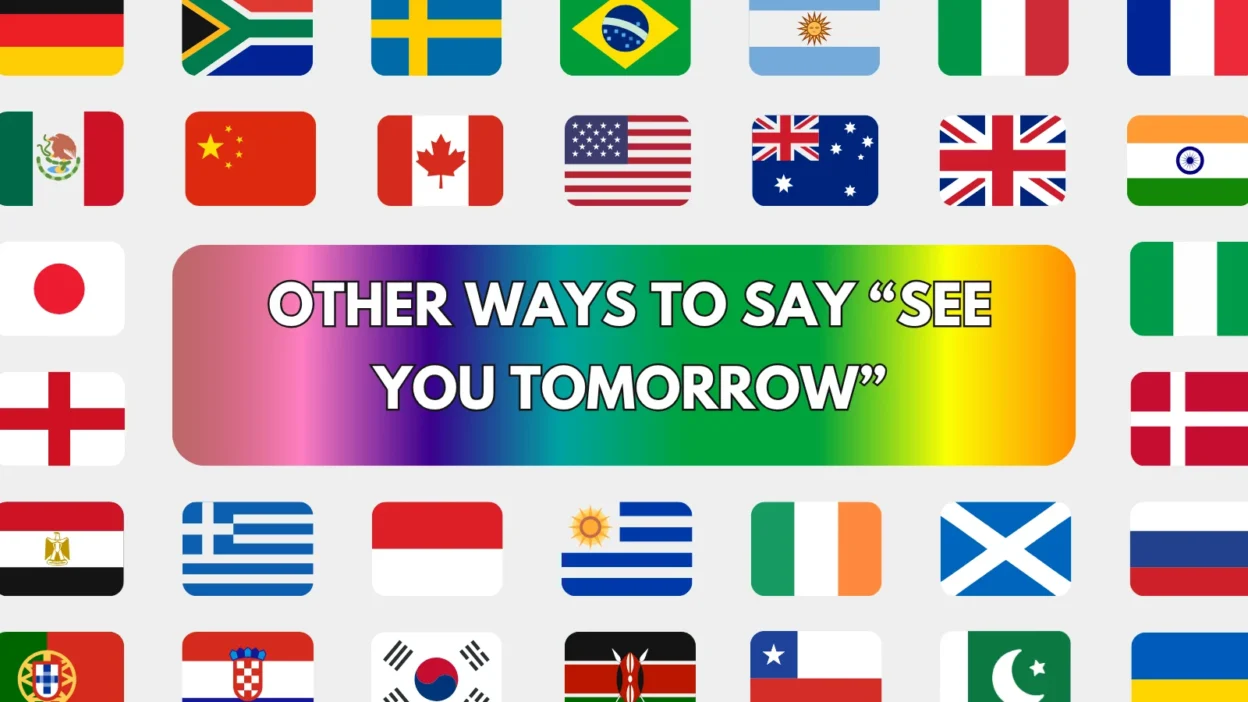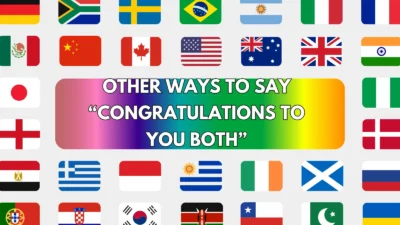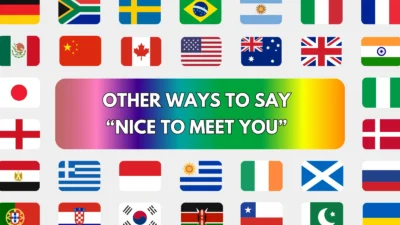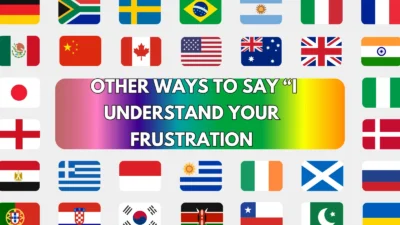“See you tomorrow” is a simple and friendly way to say goodbye when you expect to meet someone the next day. But depending on the situation — whether it’s work, school, or a casual chat — you might want to vary how you say it. Using different expressions can make your farewells sound warmer, more professional, or more personal.
Here are 25 alternative ways to say “see you tomorrow,” each with meanings, explanations, and examples to help you choose the right one for every situation.
1. Catch you tomorrow
Meaning: A casual way to say you’ll see someone the next day.
Detailed Explanation: Common among friends or colleagues in relaxed settings.
Scenario Example: Great meeting today! Catch you tomorrow for the follow-up.
Best Use: Informal conversations, friendly workplaces.
Tone: Casual, cheerful.
2. Talk to you tomorrow
Meaning: Suggests you’ll speak again the next day.
Detailed Explanation: Works well for both text and voice communication.
Scenario Example: I’ll finish the report tonight — talk to you tomorrow!
Best Use: Professional or personal chats.
Tone: Neutral, polite.
3. See you in the morning
Meaning: Indicates meeting someone early the next day.
Detailed Explanation: Perfect for morning work schedules or early plans.
Scenario Example: Don’t forget the 9 a.m. meeting — see you in the morning!
Best Use: Office or school settings.
Tone: Friendly, routine.
4. Until tomorrow
Meaning: A simple way to say goodbye until the next day.
Detailed Explanation: Slightly poetic or old-fashioned, but elegant.
Scenario Example: Thanks for your help today — until tomorrow!
Best Use: Written or polite farewells.
Tone: Warm, graceful.
5. Talk soon
Meaning: Suggests a future conversation, likely the next day.
Detailed Explanation: Common in messages or friendly chats.
Scenario Example: Let’s finalize the design tomorrow — talk soon!
Best Use: Texts, casual or professional.
Tone: Relaxed, approachable.
6. See you later
Meaning: General phrase for future meetings, including the next day.
Detailed Explanation: Versatile and works in almost any situation.
Scenario Example: It’s been great catching up — see you later!
Best Use: Everyday conversations.
Tone: Neutral, friendly.
7. Catch up tomorrow
Meaning: Suggests reconnecting or discussing something the next day.
Detailed Explanation: Often used when ongoing work or conversation will continue.
Scenario Example: We can go over the rest of the details when we catch up tomorrow.
Best Use: Work, study, or collaboration.
Tone: Professional, friendly.
8. I’ll see you bright and early
Meaning: Cheerful way to say you’ll meet someone early in the morning.
Detailed Explanation: Adds energy and positivity to the farewell.
Scenario Example: Don’t oversleep — I’ll see you bright and early!
Best Use: Work, travel, school mornings.
Tone: Playful, upbeat.
9. Same time tomorrow
Meaning: Confirms plans for the same time the next day.
Detailed Explanation: Useful for appointments or meetings.
Scenario Example: That works perfectly — same time tomorrow then!
Best Use: Scheduling or planning.
Tone: Clear, professional.
10. See you next day
Meaning: Simple version of “see you tomorrow.”
Detailed Explanation: Common in casual speech or informal text.
Scenario Example: It’s getting late — see you next day!
Best Use: Informal or friendly chats.
Tone: Easygoing, casual.
11. Until we meet tomorrow
Meaning: A slightly formal or poetic farewell.
Detailed Explanation: Sounds warm and thoughtful.
Scenario Example: Until we meet tomorrow, take care.
Best Use: Written notes, polite exchanges.
Tone: Kind, gentle.
12. Talk to you in the morning
Meaning: Indicates a conversation planned for the next morning.
Detailed Explanation: Perfect for friends, coworkers, or family.
Scenario Example: I’ll check the updates overnight — talk to you in the morning!
Best Use: Texts, casual or work messages.
Tone: Polite, relaxed.
13. Till tomorrow then
Meaning: Friendly and natural way to end a chat.
Detailed Explanation: Sounds conversational and confident.
Scenario Example: Alright, we’ve covered enough today — till tomorrow then!
Best Use: Office or study settings.
Tone: Neutral, natural.
14. I’ll see you soon
Meaning: Indicates you’ll meet again shortly, often the next day.
Detailed Explanation: Adds warmth and anticipation.
Scenario Example: I’ll see you soon — can’t wait to continue where we left off.
Best Use: Both personal and professional contexts.
Tone: Friendly, pleasant.
15. Let’s continue tomorrow
Meaning: Suggests resuming an activity the next day.
Detailed Explanation: Common at the end of meetings or projects.
Scenario Example: We made great progress today — let’s continue tomorrow.
Best Use: Work or academic tasks.
Tone: Productive, polite.
16. Catch you in the a.m.
Meaning: Casual, fun way to say “see you tomorrow morning.”
Detailed Explanation: Adds humor and informality to the farewell.
Scenario Example: Alright night owl, catch you in the a.m.!
Best Use: Friendly or humorous contexts.
Tone: Playful, informal.
17. Until next time (tomorrow)
Meaning: Farewell implying you’ll meet again soon.
Detailed Explanation: Works in both formal and friendly situations.
Scenario Example: Great work today, everyone — until next time, tomorrow!
Best Use: Team meetings, polite closings.
Tone: Respectful, optimistic.
18. We’ll pick up where we left off
Meaning: Suggests resuming the same task or discussion tomorrow.
Detailed Explanation: Great for ongoing collaborations.
Scenario Example: Let’s stop here — we’ll pick up where we left off tomorrow.
Best Use: Work or study environments.
Tone: Organized, professional.
19. Have a great night, see you tomorrow
Meaning: Combines a farewell with a friendly wish.
Detailed Explanation: Common in both professional and friendly contexts.
Scenario Example: Good job today — have a great night, see you tomorrow!
Best Use: End-of-day messages.
Tone: Warm, friendly.
20. See you at work tomorrow
Meaning: Specific to workplace interactions.
Detailed Explanation: A clear and casual way to close a conversation with coworkers.
Scenario Example: Thanks for your help today — see you at work tomorrow!
Best Use: Office, business, or meetings.
Tone: Friendly, professional.
21. Looking forward to tomorrow
Meaning: Shows excitement about seeing or meeting someone.
Detailed Explanation: Adds a positive and anticipatory tone.
Scenario Example: I’m looking forward to tomorrow — it’s going to be a good day!
Best Use: Plans, events, meetings.
Tone: Optimistic, friendly.
22. Tomorrow, same place, same time
Meaning: Confirms a repeated plan clearly.
Detailed Explanation: Often used for appointments, practices, or lessons.
Scenario Example: That went well — tomorrow, same place, same time?
Best Use: Work or scheduled activities.
Tone: Clear, polite.
23. Take care, see you tomorrow
Meaning: Adds kindness to a standard farewell.
Detailed Explanation: Combines well wishes with a friendly goodbye.
Scenario Example: Take care, see you tomorrow, and don’t forget your notes!
Best Use: Casual, friendly communication.
Tone: Warm, polite.
24. Rest well, I’ll see you tomorrow
Meaning: Adds a caring touch to your goodbye.
Detailed Explanation: Perfect for close friends, family, or colleagues.
Scenario Example: You worked hard today — rest well, I’ll see you tomorrow.
Best Use: Personal or supportive conversations.
Tone: Kind, thoughtful.
25. Until we meet again (tomorrow)
Meaning: A poetic and timeless way to end a conversation.
Detailed Explanation: Elegant and emotional, often used in writing.
Scenario Example: Until we meet again tomorrow, stay safe and happy.
Best Use: Farewell messages, letters, kind closings.
Tone: Poetic, heartfelt.
Conclusion
“See you tomorrow” can be said in many ways — from the simple “catch you tomorrow” to the warm “rest well, I’ll see you tomorrow.” Choosing the right phrase depends on your tone, relationship, and setting.
Whether casual or professional, each alternative adds a touch of variety and personality, making your goodbyes feel more genuine and memorable.




